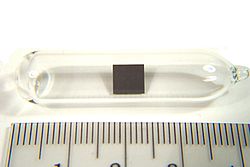
Back چرخه سوخت توریوم Persian Torium-ydinpolttoainekierto Finnish Cycle du combustible nucléaire au thorium French थोरियम ईंधन चक्र Hindi Siklus bahan bakar torium ID トリウム燃料サイクル Japanese 토륨 연료 사이클 Korean Thoriumreaktor NN Ториевый топливный цикл Russian Торієвий паливний цикл Ukrainian

The thorium fuel cycle is a nuclear fuel cycle that uses an isotope of thorium, 232
Th
, as the fertile material. In the reactor, 232
Th
is transmuted into the fissile artificial uranium isotope 233
U
which is the nuclear fuel. Unlike natural uranium, natural thorium contains only trace amounts of fissile material (such as 231
Th
), which are insufficient to initiate a nuclear chain reaction. Additional fissile material or another neutron source is necessary to initiate the fuel cycle. In a thorium-fuelled reactor, 232
Th
absorbs neutrons to produce 233
U
. This parallels the process in uranium breeder reactors whereby fertile 238
U
absorbs neutrons to form fissile 239
Pu
. Depending on the design of the reactor and fuel cycle, the generated 233
U
either fissions in situ or is chemically separated from the used nuclear fuel and formed into new nuclear fuel.
The thorium fuel cycle has several potential advantages over a uranium fuel cycle, including thorium's greater abundance, superior physical and nuclear properties, reduced plutonium and actinide production,[1] and better resistance to nuclear weapons proliferation when used in a traditional light water reactor[1][2] though not in a molten salt reactor.[3][4][5]
- ^ a b Robert Hargraves; Ralph Moir (January 2011). "Liquid Fuel Nuclear Reactors". American Physical Society Forum on Physics & Society. Retrieved 31 May 2012.
- ^ Sublette, Carey (20 February 1999). "Nuclear Materials FAQ". nuclearweaponarchive.org. Retrieved October 23, 2019.
- ^ Kang, J.; Von Hippel, F. N. (2001). "U-232 and the proliferation-resistance of U-233 in spent fuel". Science & Global Security. 9 (1): 1–32. Bibcode:2001S&GS....9....1K. doi:10.1080/08929880108426485. S2CID 8033110. "Archived copy" (PDF). Archived from the original (PDF) on 2014-12-03. Retrieved 2015-03-02.
{{cite web}}: CS1 maint: archived copy as title (link) - ^ ""Superfuel" Thorium a Proliferation Risk?". 5 December 2012.
- ^ Ashley, Stephen; Parks, Geoffrey (2012-12-05). "Thorium fuel has risks". Nature. 492 (7427): 31–33. doi:10.1038/492031a. PMID 23222590. S2CID 4414368.
We are concerned, however, that other processes, which might be conducted in smaller facilities, could be used to convert 232Th into 233U while minimizing contamination by 232U, thus posing a proliferation threat. Notably, the chemical separation of an intermediate isotope — protactinium-233 — that decays into 233U is a cause for concern. ... The International Atomic Energy Agency (IAEA) considers 8 kilograms of 233U to be enough to construct a nuclear weapon1. Thus, 233U poses proliferation risks.
© MMXXIII Rich X Search. We shall prevail. All rights reserved. Rich X Search